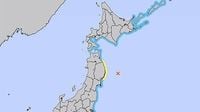On the evening of November 9, 2025, northern Japan was rattled by a powerful earthquake that sent ripples of concern across the Pacific coast of Iwate Prefecture. The quake, which registered a magnitude of 6.9, struck off the Iwate coastline at approximately 5:03 p.m. Japan Standard Time, according to both the Japan Meteorological Agency (JMA) and local news reports. The tremor’s epicenter was located at a depth between 10 and 16 kilometers beneath the sea surface, a detail that underscores the region’s vulnerability to seismic shifts and tsunami threats.
The immediate aftermath saw the JMA issue a tsunami advisory at 5:12 p.m., warning residents of possible dangerous waves. Within minutes, tsunami waves measuring up to 20 centimeters were observed in the Iwate cities of Kuji and Ofunato, as reported by Jiji Press and corroborated by the JMA. Although the advisory predicted the possibility of waves reaching up to one meter along the northern coast, the actual impact was less severe. The advisory would remain in effect for about three hours before being officially lifted at 8:15 p.m.
Despite the anxiety such warnings can spark—especially in a country with a long memory of devastating tsunamis—there were no immediate reports of injuries, structural damage, or operational issues at the two nuclear power plants in the affected area. This reassuring news was echoed by both local broadcasters and the JMA, who monitored the situation closely throughout the evening.
The earthquake registered as high as level 4 on Japan’s seismic intensity scale, which runs from 0 to 10. This made it the sixth-highest possible intensity, and the strongest tremors were felt in the capital city of Morioka and the town of Yahaba in Iwate Prefecture, as well as Wakuya in neighboring Miyagi Prefecture. Residents described the shaking as strong but not catastrophic, with most able to remain calm and follow official guidance.
One of the more immediate consequences of the quake was its impact on transportation. According to East Japan Railway Co. (JR East), the Tohoku Shinkansen bullet train line experienced a temporary power outage, resulting in suspended services between Sendai Station in Miyagi and Shin-Aomori Station in Aomori Prefecture, north of Iwate. The Akita and Hokkaido Shinkansen lines also faced delays. Local news outlets reported additional power shortages in the area, though these were resolved without major incident. For many commuters and travelers, the disruption was a reminder of how quickly daily life can be upended by nature’s unpredictability.
The JMA provided an explanation for the quake’s origin, noting that it occurred at the boundary of two tectonic plates. Here, the ocean-side plate is in the process of sliding beneath the land-side plate—a geological dance responsible for much of the seismic activity in the region. This ongoing movement is what makes Japan one of the most earthquake-prone countries in the world, and it’s a reality that shapes both infrastructure and public consciousness.
In a news conference on Sunday evening, a JMA official emphasized the need for continued vigilance. "Similar or stronger earthquakes could occur in the next few days," the official warned, echoing advice that is all too familiar to residents of the region. The agency also urged the public to be prepared for possible aftershocks, noting that many smaller quakes—ranging in seismic intensity from 1 to 3—had already been recorded off the Iwate coast through Monday, November 10.
Prime Minister Sanae Takaichi took to social media to address the nation, urging people to move away from the coast and stay alert for aftershocks and possible tsunami waves. "Please remain on alert for aftershocks and tsunami waves that could hit the area," she advised, underscoring the unpredictability of seismic events and the importance of heeding official warnings. Her message was a clear call for caution, especially given that tsunami waves can persist for several hours after the initial quake and may even grow larger over time, as the JMA explained.
For many in Iwate and the surrounding prefectures, the experience was a stark reminder of the region’s seismic reality. Japan’s Pacific coast has a long history of earthquakes and tsunamis, with some events—like the catastrophic 2011 Tohoku earthquake and tsunami—etched deeply into public memory. While Sunday’s quake was far less destructive, the swift and coordinated response from authorities reflected lessons learned from the past.
Transportation companies, emergency services, and local governments acted quickly to ensure public safety. Bullet train operators suspended services at the first sign of trouble, and the JMA’s rapid issuance and subsequent lifting of the tsunami advisory demonstrated the effectiveness of Japan’s disaster monitoring systems. In this case, the infrastructure held firm, and the public followed instructions, minimizing the risk of panic or confusion.
Even as the immediate threat subsided, experts and officials continued to monitor the situation closely. The JMA reiterated its warning that aftershocks—some potentially strong—could follow in the coming week. This advice was not merely precautionary; many residents reported feeling more tremors in the hours and days after the main quake. For those living along the coast, the possibility of further seismic activity remains a concern, one that shapes everything from daily routines to long-term planning.
Looking back, the November 9 earthquake serves as both a test and a testament to Japan’s resilience. The country’s experience with natural disasters has fostered a culture of preparedness, where public awareness campaigns, regular drills, and robust infrastructure all play vital roles. While the quake caused temporary disruptions—most notably to transportation—its limited impact on lives and property is a positive sign that these measures are working.
As the week unfolds, residents of Iwate and neighboring prefectures will remain watchful, heeding the advice of experts and staying ready for whatever comes next. For now, the region can breathe a cautious sigh of relief, knowing that—this time, at least—nature’s fury was met with calm resolve and careful preparation.




